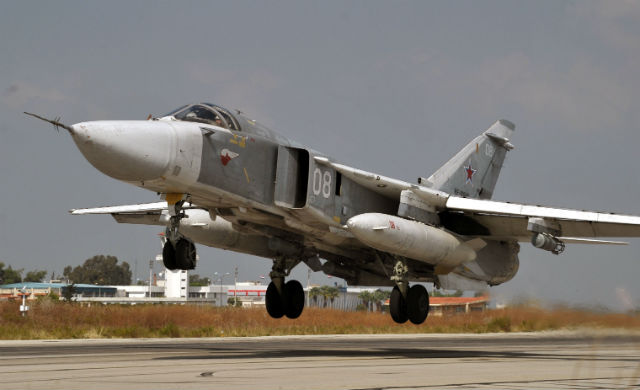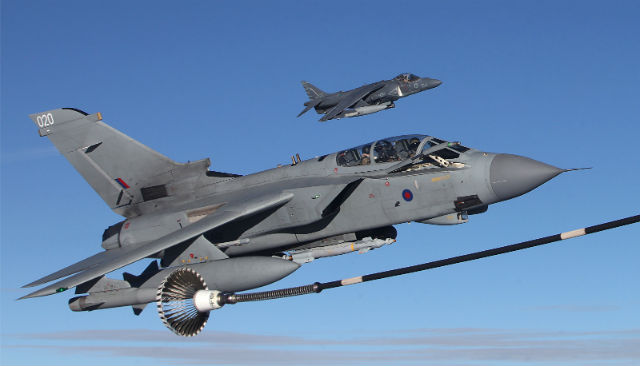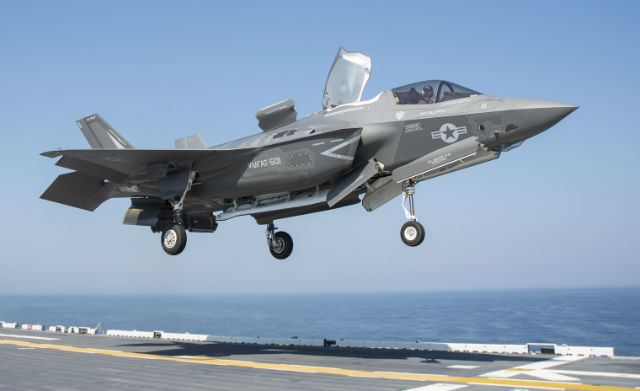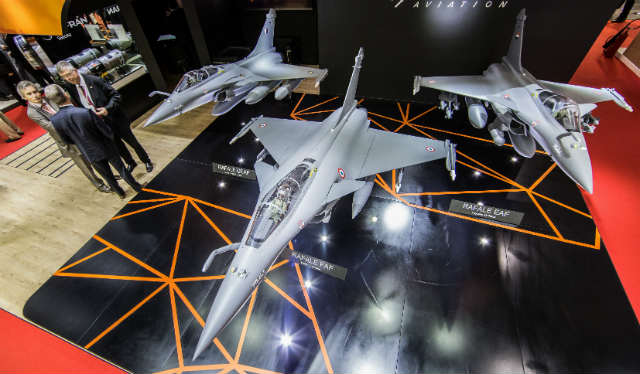Moscow increased the pressure within Syria by deploying a significant contingent of combat aircraft and helicopters, before mounting a major offensive involving not just these, but also long-range cruise missiles fired from the Caspian Sea and by its strategic bomber fleet. Its intervention complicated the make-up of an air campaign being staged by the USA and multiple other nations against Islamic State militants, and raised the spectre of a clash between deployed forces.

Xinhua/Rex Shutterstock
These tensions reached a new high in late November, following the downing of a Russian Sukhoi Su-24 strike aircraft by a Turkish air force-operated Lockheed Martin F-16 in what has for several years been the rarest of events: an air-to-air engagement. With Moscow subsequently deploying S-400 surface-to-air missiles and arming combat aircraft with air-to-air missiles, pessimists will fear such an incident could be repeated, in a theatre which is already on edge due to the numerous players and their contrasting objectives for the regime in Damascus.
Already the subject of criticism for its annexation of Crimea from Ukraine and continuing to probe NATO’s air defences in the Baltic States, Russia’s intentions remain hard to read. Coalition assets are busy responding to Moscow’s aircraft from Baltic Air Policing bases in Estonia and Lithuania, supported by quick reaction fighters in other locations, including Norway, Poland and Sweden.
Elsewhere during the activity against Islamic State and other terrorist groups, regional air forces – including those of Bahrain, Jordan, Morocco, Qatar, Saudi Arabia and the United Arab Emirates – have participated in combat along with the likes of the UK and USA, and in some cases lost aircraft.

Continued instability in parts of the Middle East is sure to see the existing level of action maintained, and in all likelihood intensified, over the coming year. As evidenced by the late October bombing of a MetroJet Airbus A321 after departure from Sharm el-Sheikh in Egypt, the threats posed to aviation by unrest are very real for airlines also. A total of 224 passengers and crew died as a result of the attack on the Russian-operated aircraft.
For the first time, our annual overview of the global military aircraft inventory has been compiled using just part of the information contained within Flightglobal’s Fleets Analyzer database. Recently launched, this holds premium-quality data on more than 345,000 aircraft, also including airliners, rotorcraft and business jets.
We record just over 52,100 military aircraft in active service around the globe, with our listing showing the fleets held by air arms in some 160 nations. This year’s fleet total represents an increase of just 0.8% from the figures contained in our directory for 2015.
Of the in-service equipment, the USA’s armed forces account for the largest share, with just over 26% of the total active inventory; slightly more than 13,700 aircraft. The bulk of a year-on-year reduction of just over 200 aircraft recorded for Washington’s military can be attributed to the retirement of 130 Bell Helicopter OH-58 Kiowa Warrior armed scouts and some of its Bell 206-based TH-67A Creek trainers, at the start of a major aviation restructuring. More cuts will follow next year, but Congressional action has so far saved the US Air Force from long-threatened reductions to its Fairchild-Republic A-10 ground-attack fleet.
Our data shows that only the North America region experienced a within-year total fleet reduction, while the numbers stayed flat in Europe and Latin America. The biggest increases – of 3% each – were in the Middle East and Russia and Commonwealth of Independent States groupings, while Asia-Pacific and Africa saw rises of 2%.
In addition to the active fleet, another 4,500 aircraft are recorded as being the subject of firm orders, while more than 8,250 more are the subject of pending deals, letters of intent or national procurement plans.
Among the most significant fleet developments of 2015, Lockheed’s F-35 can now be listed as an operational type, with the short take-off and vertical landing B-model variant having achieved initial operational capability (IOC) status with lead user the US Marine Corps.

US Navy
Our data shows 26 combat-rated examples as being in the service’s inventory, supported by another 11 aircraft which are allocated as training assets.
The USAF should follow suit in declaring IOC readiness towards the end of 2016, with the conventional take-off and landing F-35A. Its first “combat-coded” pair of Lightning IIs were received earlier this year in advance of the development.
Other boosts for the F-35 programme have included full commitments from Norway and the UK – respectively for 48 and 138 frontline examples – and production examples are under contract for these nations, plus Israel, Italy, Japan and the three US services. However, the election of a new government in Canada has cast doubt on Ottawa’s long-held commitment to the type, and Lockheed’s rivals are also sniffing opportunities to potentially edge the F-35 out of the picture in nations like Belgium.
Against this backdrop, Lockheed and the US programme office can be expected to mount a major campaign to showcase the F-35 during 2016, with an appearance at the Royal International Air Tattoo and Farnborough air show all but certain.
While the F-35 continues to make progress towards operational utility, 2015 was a remarkable year for one of the fighter sector’s more proven products. After years of campaign disappointments, Dassault in February secured its first export order for the Rafale – then two months later its second. A first batch of three, twin-seat examples has been supplied to Egypt, under the nation’s 24-unit deal, while Qatar is to acquire 36.

The Eurofighter consortium appears poised for success with its third Middle Eastern customer, with Kuwait announcing a pending deal for 28 Typhoons – the final details for which are being worked out with the Italian government. Success could mean the end of Boeing’s hopes of selling its production-threatened F/A-18E/F Super Hornet to the Kuwait air force, although the company believes a deal could be done regardless of a selection of the European type. The manufacturer is counting on additional orders from the US Navy and potentially other export buyers to extend production of the carrier-optimised type beyond late this decade.
Saab’s Gripen has also enjoyed success, with Brazil having finalised a contract for its first 28 NG-model examples, and the first Embraer engineers are in Sweden to develop their skills on the single-engined type. The coming year will see a first flight of the lead example of three prototypes of the E-model version being produced first for Sweden, with final assembly starting recently.
At the heavier end of the spectrum, Northrop Grumman won selection to build the USAF’s planned fleet of 100 long-range strike bombers, although the award remains the subject of a challenge from a rejected Boeing and Lockheed team. If confirmed, the proposed $80 billion deal will safeguard Northrop’s legacy as a bomber manufacturer, and eventually deliver replacements for the service’s veteran Boeing B-52Hs – 77 of which remain in use today – and younger B-1Bs.
The airlift sector has seen the C-17 strategic airlifter exit production, after final unit sales to nations including Australia, Canada and Qatar. With the US type no longer on offer, Airbus Defence & Space has yet to capitalise on export opportunities with its A400M. The European manufacturer is struggling to deliver its promised tactical capabilities, and a fatal accident in May 2015 led to a brief suspension of flights. But operational experience is growing, with five nations now operating the type and Spain to receive its first example during 2016.
Embraer’s KC-390 took to the air in February, but did not fly again until late October, partly due to a funding crisis in the Brazilian defence ministry. Strong progress is needed if the transport and tanker is to enter service as planned during 2018. Despite the challenges facing the company, Antonov’s An-178 also made its debut during 2015, and was present at the Paris and Dubai air shows.
For the first time in several years, the spoils were shared in the tanker sector, with Airbus Defence & Space taking a four-aircraft contract in South Korea with the A330 MRTT and Boeing getting a first international order for its 767-derived KC-46A, with Japan to take three. This rivalry will intensify in 2016, as Boeing anticipates the receipt of a low-rate initial production decision from the USAF.

Boeing
Notable retirements in 2015 included the bulk of the UK’s search-and-rescue-tasked Westland Sea Kings, whose services are being assumed by civilian aircraft via the Long SAR programme, and the last of Argentina’s Dassault Mirage III and Mirage 5 fighters. The latter’s air force must adapt to degraded capability, as an expected deal to acquire upgraded Kfir fighters from Israel Aerospace Industries failed to reach the contract stage.
Excluded from our listing are 770 military fixed-wing aircraft and helicopters recorded as dedicated to VIP transport, and 550 for research and development and experimental activities.
Other exclusions include more than 5,200 aircraft in storage – also counting those involved in or awaiting upgrade – and piston-engined types, on which our database does not hold information.
Source: Flight International
















